José González
INSTITUTO DE ESTRUCTURA DE LA MATERIA
CONSEJO SUPERIOR DE INVESTIGACIONES CIENTÍFICAS
| Home | Career | Research lines | Publications | Talks |
|
TWISTED BILAYER GRAPHENE |
|
The experimental observation of superconductivity in twisted bilayer graphene has been one of the most outstanding discoveries carried out during the last years in the context of condensed matter physics. It has certainly attracted much attention as the first instance in which a material made purely of carbon has proven to be superconducting, in the absence of any chemical doping. Moreover, this discovery represents a change of paradigm when looking for materials with unconventional superconductivity, as chemical complexity is replaced here by the structural complexity of the twisted bilayers, which become superconducting near the so-called magic twist angle, when the period of the resulting moiré superlattice is above 10 nanometers.
Electronic transport in twisted bilayer graphene
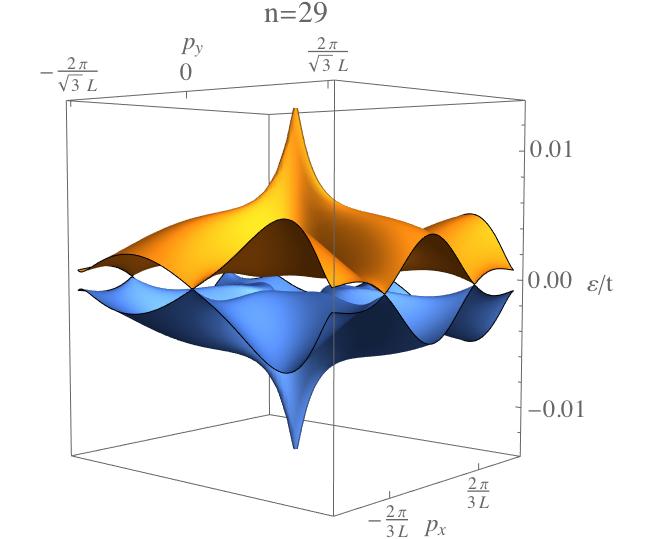
We have developed a proposal to explain the strange metal phase observed in twisted bilayer graphene by the group of Pablo Jarillo-Herrero at MIT. The main feature characterizing that phase is the linear temperature dependence of the resistivity above the superconducting phase found near half-filling of the Moiré superlattice. While it is frequently assumed that the electron-phonon interaction could be responsible for that anomalous behavior, it has been acknowledged that phonons cannot account for the linear dependence down to the lowest temperatures reached in the experiment (∼ 0.5 K). Our proposal has served to solve this puzzle, presenting a consistent explanation which is purely based on the electron-electron interaction. Our key observation has been that the lowest-energy bands of twisted bilayer graphene near the magic angle display two distinct features that dominate the transport properties. These are the Dirac nodes at the charge neutrality point and, on the other hand, a set of extended saddle points which are close to the Fermi level at half-filling of the low-energy valence and conduction bands. We have shown that the decay of the electron quasiparticles in the region of flat dispersion of the saddle points, as well as of those with higher energy (already located in the Dirac cones below the nodes at the K points) can account for the linear temperature dependence of the resistivity. In the flat region of the saddle points, the reason for the anomalous behavior lies in the linear growth with energy of the electron-hole excitations across the Fermi line. Thus, our derivation can be seen as a concrete realization of the marginal Fermi liquid paradigm, which was developed phenomenologically many years ago to describe the normal phase of the copper-oxide high-temperature superconductors. We have concluded that such an unconventional behavior should have also a reflection in other observable features, like the linear energy scaling of the electron quasiparticle decay rate, or the anomalous temperature dependence of the heat capacity and the thermal conductivity.
Superconductivity in twisted bilayer graphene
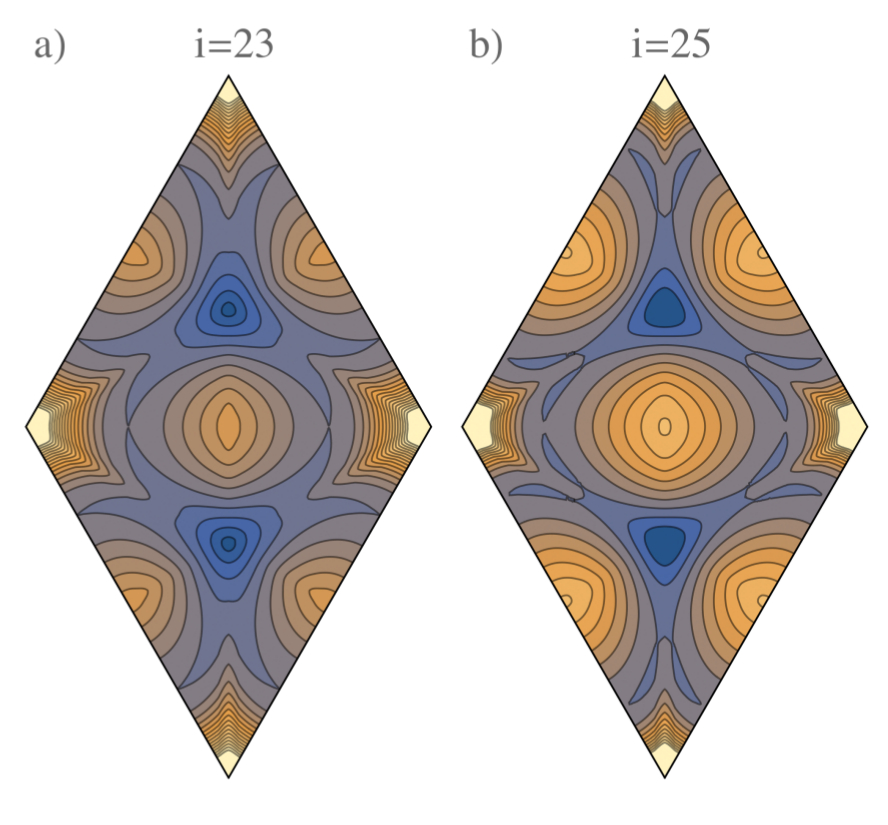
We have put forward a comprehensive microscopic theory which places the origin of the superconductivity of twisted graphene bilayers in the highly anisotropic Fermi line developed at the small twist angles where they become superconducting. Our theoretical construction can be considered as a variant of the so-called Kohn-Luttinger mechanism, which was devised as an alternative route to superconductivity starting from a purely repulsive Coulomb interaction. Usually, the Kohn-Luttinger instability takes place at extremely low energy scales but, in twisted bilayer graphene, it is amplified by the doubling and subsequent strong coupling of the van Hove singularities of the electronic spectrum as the magic angle is approached, leading to quite extended saddle points in the highest valence band. In these circumstances, we have found that the highly anisotropic screening along the Fermi line is able to induce an attractive channel in the effective electron-electron interaction. This is the seed required to trigger a superconducting instability, which takes place in our model at a low-energy scale which is consistent with the critical temperatures observed in the experiments. Moreover, we have also shown that the large density of electron-hole excitations from the given Fermi line is able to develop a spin-density-wave instability adjacent to the superconducting instability, for doping levels close to the van Hove singularity in the spectrum. This may also explain the existence of the insulating phase observed at half-filling of the moiré superlattice, which seems to play the role of parent phase for the superconducting regime, and it is the other key ingredient in the puzzling resemblance of the phase diagram of the twisted bilayers to that of such strongly correlated systems as the high-Tc superconductors.
Non-Abelian gauge potentials in graphene bilayers
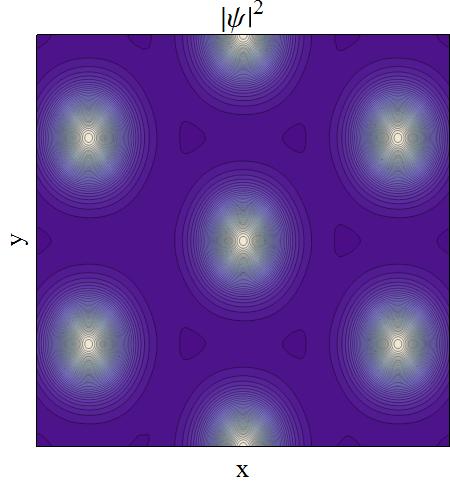
We have studied the possibility of localizing electrons in graphene by means of synthetic gauge fields, created by the mismatch in the lattice registry of strained or twisted bilayers. It is known that the most favorable regular structure of graphene bilayers corresponds to the so-called Bernal or AB stacking, in which the carbon atoms in a sublattice of one of the layers fall onto the atoms in the complementary sublattice of the other layer. When the lattices are distorted, either by strain, shear or twisting, the perfect registry is lost, and one observes the appearance of typical Moiré patterns where regions of AB stacking alternate with others realizing AA stacking, in which the carbon atoms in one of the layers fall onto homologous atoms in the other layer. We have shown that the alternation between the two types of stacking produces the same effect as having a non-Abelian SU(2) gauge potential, with the ability of confining electrons in those regions of the bilayer where the periodic effective field strength becomes maximum. By applying uniaxial shear to one of the layers, for instance, we can create a quasi-one-dimensional Moiré pattern with a perfect sequence of AA-AB-BA stacking along one of the directions of the bilayer. In this case, the electronic density can be confined into 1D channels corresponding to the regions with AA stacking, or AB-BA stacking, depending on the longitudinal momentum of the electronic states. The band structure becomes strongly reminiscent of that found in thick carbon nanotubes in a real perpendicular magnetic field, where there is also a periodic modulation of the flux around the section of the tube. The lowest-energy subband becomes extremely flat for large period of the stack modulation, corresponding to states localized in the regions of AB and BA stacking. Beyond a certain value of the longitudinal momentum, the electronic states start to disperse along branches linear in energy. This signals the development of propagating modes along the one-dimensional channels with AA stacking, in close analogy with the behavior of the edge states in the quantum Hall effect of a 2D electron liquid in a real magnetic field. We have also applied our gauge field approach to understand the electronic properties of twisted bilayers, where the relative rotation of one layer with respect to the other induces a superlattice with alternating regions of AA, AB and BA stacking. We have seen that the electron system develops an extremely flat lowest-energy subband for certain magic values of the rotation angle, showing that this feature is a direct consequence of the presence of an effective non-Abelian SU(2) gauge field across the bilayer. The lack of dispersion is actually the signature of localized low-energy states that are bound in this case around the regions of AA stacking, giving rise to a triangular array of quantum dots. We have found that this pattern of confinement is consistent with the periodicity of the maxima in the effective field strength, and that the first (largest) twist angle at which the lowest subband becomes flat corresponds to the point where the unit cell of the superlattice is thread precisely by the quantum of flux. The present approach supports in general the possibility of using the graphene bilayers to realize non-Abelian Aharonov-Bohm interferometry, by which the amplitude of electrons injected into one of the layers may oscillate and even become completely transferred to the other layer along their propagation. Furthermore, our study may also open a new route to address the problem of localization of electronic states, which are not effectively constrained by scalar potential barriers in graphene, but may be otherwise confined and manipulated in electronic devices made of graphene bilayers.
|
|
3D DIRAC AND WEYL SEMIMETALS |
|
The interest in this subject comes from the discovery of 3D materials that have linear electronic dispersion in all the directions of the momentum, thus providing a kind of higher-dimensional analogue of graphene. These 3D systems are dubbed Dirac or Weyl semimetals to emphasize that their electronic quasiparticles are endowed with a relativistic-like invariance that mimics the symmetry of fundamental particles in high-energy physics. In this respect, the 3D semimetals are governed by a modified version of Quantum Electrodynamics (QED) in which the speed of light is replaced by the Fermi velocity of the electron quasiparticles, providing therefore an instance of electron system which is naturally prone to the strong-coupling regime.
Surface and 3D quantum Hall effects in nodal-line semimetals
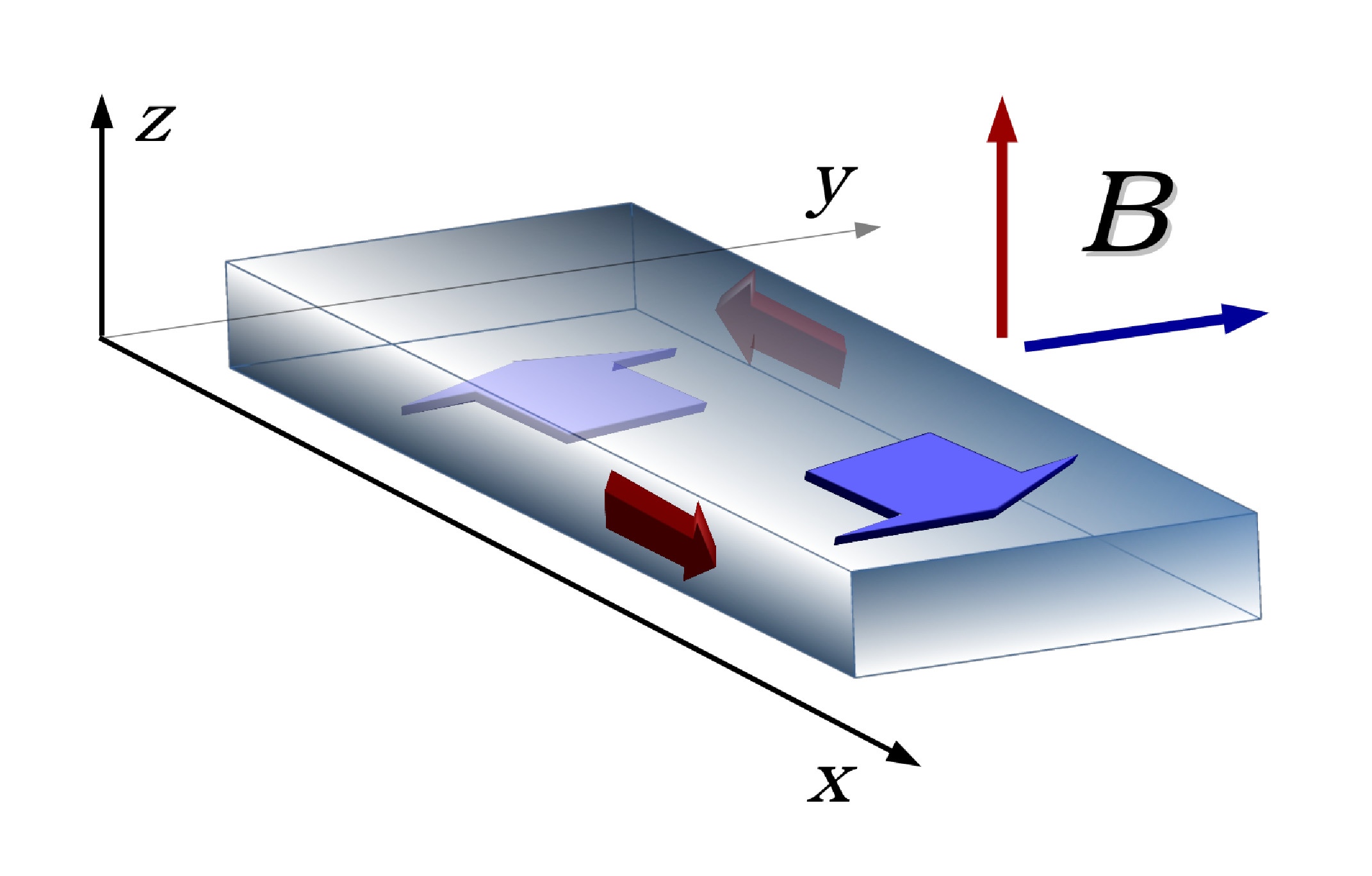
We have unveiled the potential of the 3D nodal-line semimetals to support a phenomenon which is the analogue of the 2D quantum Hall effect but promoted to a higher spatial dimension. We have shown that, when the magnetic field is perpendicular to the nodal ring, the evanescent states of the nodal-line semimetal remain stabilized in a zero-energy level with huge 2-parameter degeneracy arising from the collapse down to zero-energy of a large number of 2D-like Landau levels. We have found that there is a deep reason for the topological protection of these Landau surface states as they correspond to exceptional points, i.e. branch points which arise upon extension of the spectrum to complex values of the momentum. In this context, we have seen that one can apply the properties of such exceptional points to account for the quantization of the Hall effect in 3D slabs of nodal-line semimetals. Quite remarkably, we have also found that a magnetic field parallel to the nodal ring has the effect of pairing the evanescent waves inside the bulk of the semimetal, leading to states that reside in parallel 2D slices of the 3D material. This constitutes a perfect version of 3D quantum Hall effect, of which very few examples are known. We have seen that, in thin films of nodal-line semimetals, the Landau states with genuine 2D extension form a flat band in the bulk but start to get some dispersion as they approach the surface of the semimetal. This explains that the electronic transport takes place through chiral surface states, which are the analogue of the edge excitations for this exotic kind of 3D Hall effect. We have performed numerical calculations to estimate that a surface Hall effect may in general survive when the nodal-line semimetal is under perturbations with a strength smaller than the gap between the zero-energy Landau level and the next higher bands. Nevertheless, we have seen that, when the perturbations preserve the particle-hole symmetry of the electron system, the complex structure tied to the exceptional points lends a much larger stability to the zero-energy flat bands in the spectrum. In these conditions, the Hall conductivity can be expressed in terms of the integral of a suitable Berry connection, in the same fashion as in the 2D Hall effect. As a counterpart, we have also shown that the complex structure of the spectrum (for complex values of the momentum) allows to express the number of zero-energy flat bands in terms of a new topological invariant, counting essentially the number of exceptional points and ensuring its topological character from the impossibility of removing such branch points by smooth perturbations of the spectrum.
Surface currents in 3D semimetals under circularly polarized light
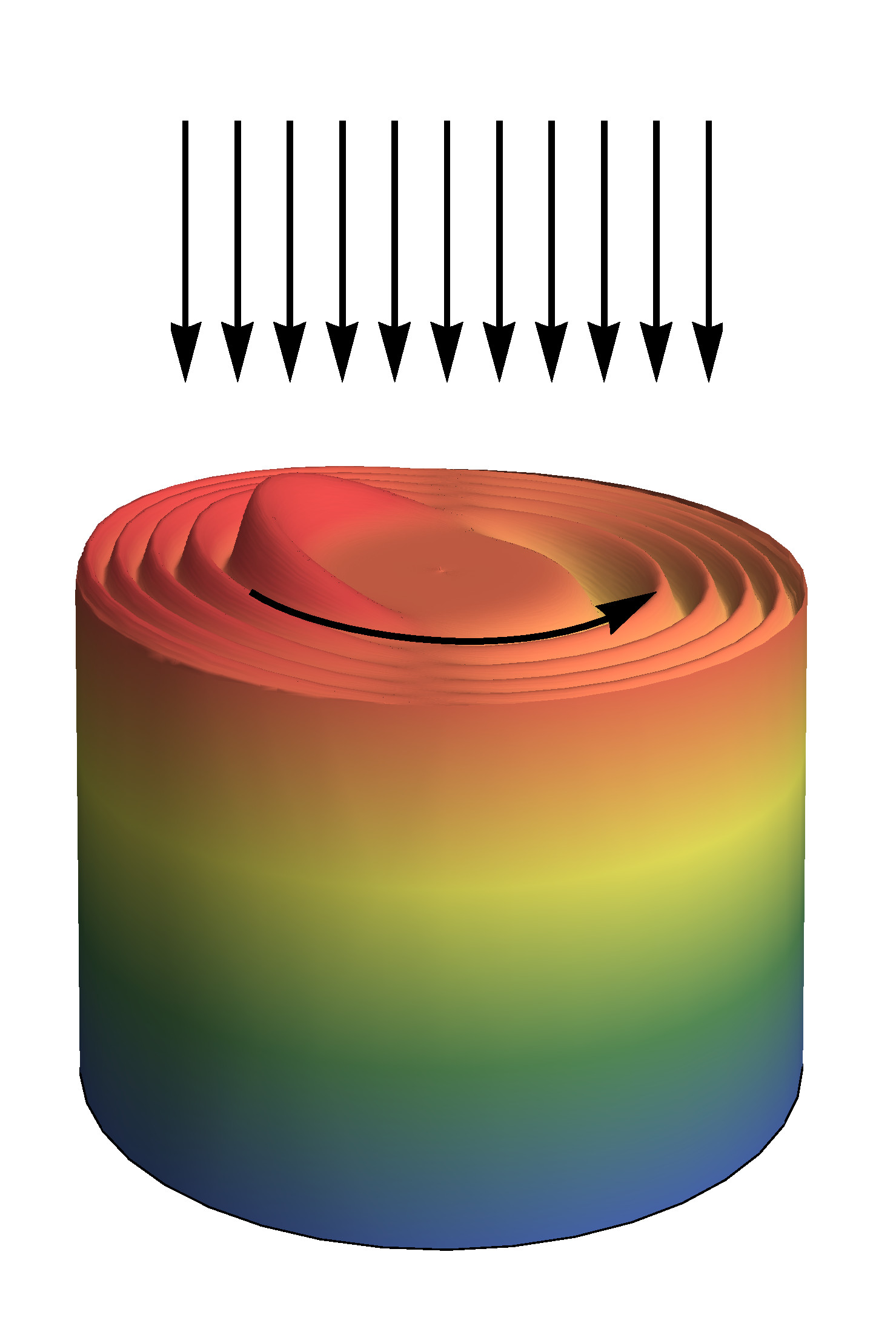
We have investigated the interaction between light and matter in the three-dimensional semimetals, focusing on the effects of circularly polarized electromagnetic radiation on the electron system. For that purpose, we have applied two different methods, consisting in the use of Floquet theory to obtain approximate solutions of the time-dependent Schrödinger equation, on one hand, and mapping that equation by means of an appropriate unitary transformation into a time-independent eigenvalue problem, on the other hand. Both approaches have allowed us to gain insight about the gaps that open up at particular points in the spectrum. Most interestingly, we have also seen that the light-matter interaction leads to the appearance of midgap states, which have the character of evanescent waves decaying from the surface of the semimetal exposed to the radiation. We have established an interesting connection between the midgap evanescent states and the existence of so-called exceptional points in the hamiltonian describing the interaction between light and matter. In fact, the zero-mode evanescent states can be understood as branch points of the spectrum at which the gap closes, for momenta inside the complex plane. This endows the zero-mode surface states with a novel mechanism of topological protection, since the branch cuts cannot be undone unless the branch points coalesce in pairs. We have seen that these novel surface states have in general a large degeneracy proportional to the area of the irradiated surface and the amplitude of the radiation field. This may give rise to the development of a flat band of localized states, providing an alternative to the usual Landau quantization in which the role of the magnetic field is here replaced by the radiation field. We have shown that the genuine feature of the midgap surface states is that they all carry angular current, with the same chirality of the photon polarization, leading to a rotation of their charge which is synchronized with that of the radiation fields. This must lead to the observation of a macroscopic chiral current across the surface exposed to the radiation, demonstrating a novel mechanism for the transfer of radiation energy driving directly the rotation of the quantum states in the electron system.
Strong-coupling phases in 3D semimetals
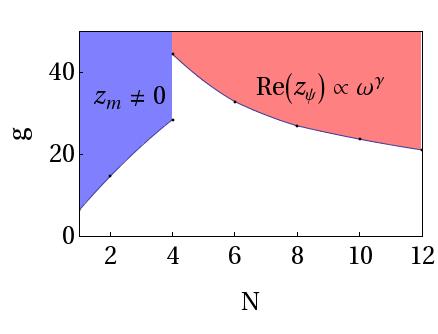
To address the properties of the strongly interacting QED in these systems, we have dealt first with an analytic approach to obtain the renormalization of the main physical parameters, like the Fermi velocity and the quasiparticle weight. In this task, we have relied on a 1/N expansion, formally assuming a large number N of Dirac fermions, which has allowed us to obtain the dependence on the energy scale of the different renormalized parameters. Thus, by computing the anomalous dimension of the electron field and the scaling of the Fermi velocity, we have been able to show that the theory has a critical coupling at a certain value of the interaction strength (expressed as the ratio between the square of the electron charge and the Fermi velocity). We have found that the critical point is characterized by the vanishing of the quasiparticle weight in the low-energy limit, following a trend in which the Fermi velocity remains bounded. This represents a novel phase in the QED of Dirac semimetals, which in two spatial dimensions (graphene-like systems) are instead characterized by the divergence of the Fermi velocity at weak coupling and by the development of an excitonic instability at strong coupling. The behavior unveiled for the 3D Dirac semimetals falls indeed into the class of marginal Fermi liquids, proposed some time ago to make sense of the unconventional properties of the normal phase of high-temperature superconductors, and having as a distinctive feature the strong attenuation of electron quasiparticles. On the other hand, the study of the phases of the 3D Dirac semimetals for not too large N has required the use of a complementary approach, based on the resolution of the Schwinger-Dyson equations of the corresponding QED. This is a nonperturbative method that has to be implemented in general with some kind of truncation to guarantee its practical feasibility. In this regard, we have relied on a formulation of the equations that amounts to including all kinds of diagrammatic contributions except those containing vertex corrections. To make contact with the previous results obtained from the renormalization of the quasiparticle parameters, we have carried out a self-consistent resolution for the Dirac propagator, characterized by frequency and momentum-dependent forms of the quasiparticle weight, the Fermi velocity and an additional Dirac fermion mass. In this approach, the recursive resolution of the integral equations has been achieved by attaining convergence after 20-30 iterations. For small values of N, we have found that the solution of the equations displays the spontaneous generation of a fermion mass at strong coupling, signaling a regime with chiral symmetry breaking that is akin to a well-known similar phase in the two-dimensional Dirac semimetals. At intermediate/large values of N, however, we have seen that the system has a transition for sufficiently strong interaction into a phase with suppression of the electron quasiparticles, in agreement with the results of the analytic large-N approximation. The self-consistent resolution has made also possible to study the behavior of the system beyond the point of the transition, allowing us to characterize precisely the properties of a strongly renormalized electron liquid and, therefore, providing a valuable paradigm for other instances of materials showing non-Fermi liquid behavior.
|
|
GRAPHENE |
|
Over the last years we have carried out investigation on the electronic properties of the so-called graphene, that is, the material made of a one-atom-thick sheet of carbon atoms, bonded with the typical honeycomb structure of the graphite layers. Since its discovery in 2004, the research on graphene has raised mounting interest in the condensed-matter community, as the genuine two-dimensional character of the material has shown to lead to many unconventional properties regarding its electronic, optical, and elastic behavior.
Chiral symmetry breaking in graphene
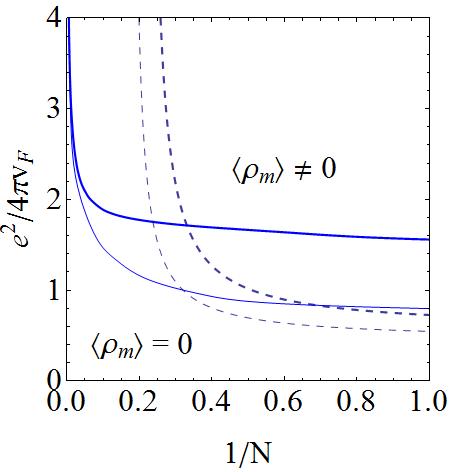
We have investigated the dynamical generation of a gap in graphene, analyzing in particular the impact that the electron self-energy corrections may have on the chiral symmetry breaking in the interacting theory of Dirac fermions. Our starting point has been the ladder approximation for the electron-hole vertex appearing in the response function for dynamical gap generation, which we have improved by including systematically the self-energy corrections to electron and hole states in the ladder series. Thus, we have been able to account for the effect of the Fermi velocity renormalization on the critical coupling for dynamical gap generation. In this respect, the growth of the Fermi velocity at low energies has been already observed in experiments carried out by the group of A. K. Geim with graphene at very low doping levels. Our results have actually shown that the effect of renormalization of the Fermi velocity induces a significant reduction in the strength of the dynamical symmetry breaking. We have found that the dynamical gap generation may take place above a critical value in the graphene fine structure constant αc ≈ 4.9, in the case of static RPA screening of the interaction potential in the ladder series, and above a value αc ≈ 1.75 in the more sensible instance of dynamical screening of the interaction. The main conclusion of our work is that the value of αc resulting from the most accurate treatment of the many-body corrections still remains below the nominal value of the graphene fine structure constant in vacuum. This means that an isolated free-standing layer of the material should be in the phase with dynamical gap generation, in agreement with most part of precedent theoretical studies on the subject, but apparently at odds with the experimental measures in suspended graphene samples. A key observation is however that, if chiral symmetry breaking is to proceed in graphene according to our estimates, it should lead to a gap at least three orders of magnitude below the high-energy scale of the Dirac theory. This suggests then that the dynamical gap generation cannot be discarded in isolated free-standing graphene, though its experimental signature may be only found in suitable samples, for which the Fermi level can be tuned within an energy range below the meV scale about the charge neutrality point.
Electron-induced rippling of graphene
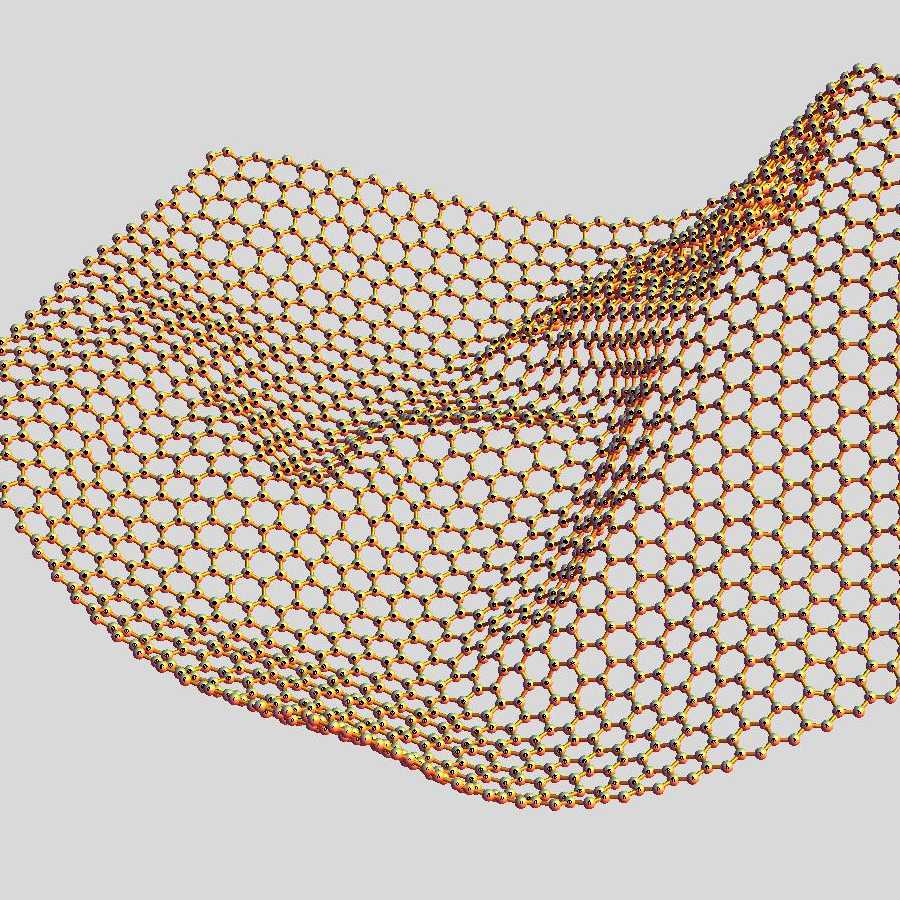
Graphene can be considered as a prototype of electronic crystalline membrane, where the mobile electrons are strongly coupled to the phonons of the two-dimensional lattice. A remarkable and unexpected property observed in graphene is its tendency to develop ripples, or long wavelength modulations of the out-of-plane displacements, by which the system freezes into a corrugated average configuration. Ripples are an important feature of graphene, as they are expected to have a significant impact on transport properties, and their origin has been heavily debated. In exfoliated graphene, ripples are correlated to some extent with the irregularities of the substrate. But it has been also observed, mainly from experiments in suspended graphene, that they also arise in part as an effect intrinsic to the crystalline membrane. In our work, we have focused on the behavior of graphene as an electronic membrane in order to investigate the rippling instability. A key observation is that the studies of more conventional membranes have shown that these have in general a flat phase with increasing rigidity over large length scales. We have then argued that the novel factor peculiar of graphene, the mobile electrons, must play an important role in the ripple formation mechanism. Within the framework of quantum many-body theory, we have devised a self-consistent approach supplemented by a renormalization group method to evaluate the contribution of the electrons to the phonon self-energy corrections. The nonperturbative character of this approach has allowed us to find a critical value of the electron-phonon coupling at which the effective bending rigidity of the membrane vanishes. This effect takes place at zero temperature and corresponds then to the transition to a new ground state of the system, characterized by the spontaneous breakdown of the translational symmetry of the flat membrane. We haven shown that this follows a mechanism similar to that responsible for the condensation of the Higgs boson field in elementary particle physics, with an order parameter given in graphene by the square of the gradient of the flexural phonon field. The effective potentials for both quantum fields (the vertical displacement in graphene, the Higgs field in relativistic physics) have actually the same typical "mexican-hat" shape, which makes the unstable state at the top to spontaneously decay by rolling down to a lowest-energy state with broken symmetry (the aggregate of ripples in one case, the Higgs condensate filling the vacuum in the other). We have shown that the analogue goes even further, since graphene has a control parameter (the tension of the membrane) that plays the same role as the mass square for the Higgs field, driving the instability in the case of compression (negative tension). Choosing suitable values of the parameters, we have seen that the proposed model leads to a predicted buckled phase which is consistent with experimental observations of the ripples, illustrating another way to employ graphene as a test ground of fundamental concepts in theoretical physics.
Doping graphene into superconductivity
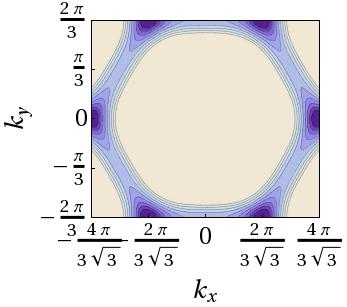
The investigation of the ground state of graphene at large doping levels has been undertaken in collaboration with the experimental group of E. Rotenberg in the Lawrence Berkeley National Laboratory. One of the key observations of this group has been that, under suitable conditions of chemical doping, the Fermi level can be tuned to the Van Hove singularity in the conduction band of the two-dimensional carbon material. It is known that the divergent density of states in the vicinity of that kind of singularity may lead to different types of instabilities in the two-dimensional electron liquid. In our case, we have modeled the specific geometry of the extended saddle-points that arise in the conduction band of graphene, which tend to develop ridges with almost flat dispersion along the boundary of the Brillouin zone. This extended character of the singularity had only precedent in the observation of the band dispersion of high-temperature superconductors. The theoretical analysis has shown indeed that superconductivity is one of the possible electronic instabilities that may appear when graphene is close to the Van Hove singularity in the conduction band. We have reached that conclusion by computing the BCS vertex conveniently dressed within the random-phase approximation, and finding the renormalized e-e couplings in the different representations of the point symmetry group. Near the Van Hove singularity, the strong modulation of the density of states along the Fermi line leads always to the existence of a negative coupling, which triggers the superconducting instability at sufficiently low temperature. We have complemented this analysis by looking also for a possible magnetic instability in the system, which could arise as a consequence of the large density of states near the Van Hove singularity. For that purpose, we have computed the magnetic susceptibility as a function of the temperature to check its divergence against the strength of the pairing instability, finding out that the latter prevails throughout all the range of relevant values of the bare Coulomb repulsion and chemical potential about the Van Hove singularity. Combined with the experimental side of the collaboration, our results have supported the idea that doped graphene can achieve an electronically-mediated superconductivity, provided that the doping is in the vicinity of the Van Hove singularity and the lattice symmetry is preserved, i.e. the chemical dopants do not introduce new states near the singularity to disrupt the band structure.
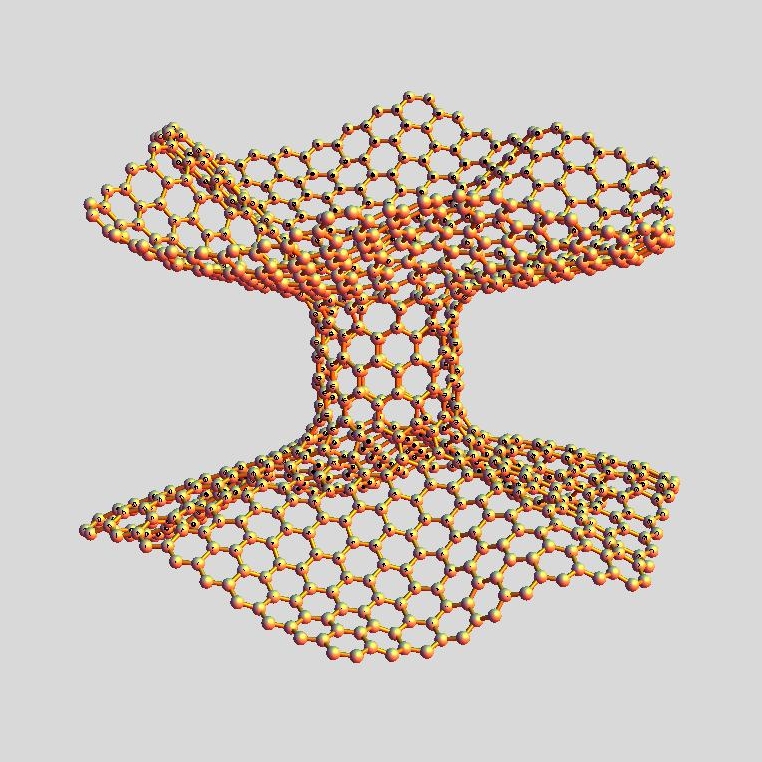
We have studied the effects of strong curvature in graphene continuing with our investigation of the carbon nanotube-graphene junctions. In this regard, it is quite promising that such hybrid structures have been already produced in the Fujitsu laboratories, while it is also conceivable that graphene wormholes may be fabricated starting from the easily available graphene bilayers. Our theoretical analysis has focused on wormhole geometries in which a short nanotube acts as a bridge between two graphene sheets, where the honeycomb carbon lattice is curved from the presence of 12 heptagonal defects. By taking nanotube bridges of very small length compared to the radius, we have developed an effective theory of Dirac fermions to account for the low-energy electronic properties of the wormholes in the continuum limit. In this construction, we have included appropriately the effect that the heptagonal carbon rings induce on the Dirac fields encoding the low-energy electronic excitations of the carbon material. This action has been mimicked by attaching a line of fictitious gauge flux at each topological defect, following the same procedure applied long time ago in the case of the fullerene lattices. The graphene wormholes represent actually an instance which can be considered to some extent dual to the case of the fullerenes, as the 12 pentagonal carbon rings in those closed lattices play a role opposite to that of the heptagonal defects in the wormhole. We have found in particular that, when the effective gauge flux from the topological defects becomes maximal, the zero-energy modes of the Dirac equation can be arranged into two triplets, which can be thought as the counterpart of the two triplets of zero modes that arise in the continuum limit of large spherical fullerenes. We have further investigated the graphene wormhole spectra by performing a numerical diagonalization of tight-binding Hamiltonians for very large lattices realizing the wormhole geometry. In this way, we have shown the correspondence between the number of localized electronic states observed in the numerical approach and the effective gauge flux predicted in the continuum limit. We have then concluded that graphene wormholes can be consistently described by an effective theory of two Dirac fermion fields in the curved geometry of the wormhole, opening the possibility of using real samples of the carbon material as a playground to experiment with the interaction between the background curvature and the Dirac fields. It is therefore plausible that the study of these condensed matter systems may allow the investigation of relevant gravitational effects related to the Dirac character of the electron quasiparticles, which otherwise would be only accessible at the much higher energies typical of the astrophysical phenomena.
Lifetime of electron quasiparticles in graphene
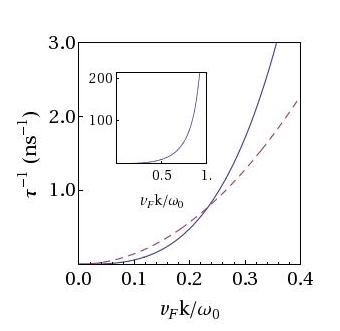
We have addressed the question of how large can the lifetime of electronic states be when graphene is close to the charge neutrality point, carrying out an exhaustive analysis of all the sources of decay. The scattering of quasiparticles by acoustic phonons provides an upper bound to the lifetime at very low energies. This channel leads to a decay rate proportional to the square of the quasiparticle energy, with a prefactor given by the ratio between the speed of sound and the Fermi velocity of the electron system. There have been however experimental results pointing at the existence of other sources of scattering which do not follow the expected trend for acoustic phonons, starting from the observed deviations from the linear behavior of the resistivity at low temperatures. These experimental measures have motivated the investigation of the low-energy excitations and decay channels arising below the scale of the in-plane optical phonons. Thus, we have seen that there is a strong coupling between electron-hole pairs and out-of-plane phonons at the momentum transfer connecting the two inequivalent Dirac points in graphene. This effect turns out to give rise to a branch of hybrid states with energy below the threshold for the creation of electron-hole pairs. We have also shown that the resulting soft modes provide then the relevant channel for the scattering of quasiparticles, leading to a decay rate proportional to the cube of the energy below the scale of the out-of-plane phonons (~ 70 meV). Moreover, we have found that the contribution of the hybrid modes to the quasiparticle scattering is progressively switched off as the Fermi level goes away from the charge neutrality point. These results have been consistent with the transport measurements carried out in graphene as a function of the temperature, where it has been seen that the linear regime of the resistivity ends at a scale of the order of ~ 150 K. Our analysis has also determined the existence of a crossover from the decay rate characteristic of the acoustic phonons at very low energies to the enhanced decay arising from the low-energy hybrid states made of out-of-plane phonons and electron-hole pairs. Beyond that, our results offer the possibility of estimating the mean free path in clean graphene samples, showing that there may be coherent transport up to distances well above the micron scale, at quasiparticle energies of the order of several tens of meV.
Carbon nanotube-graphene junctions
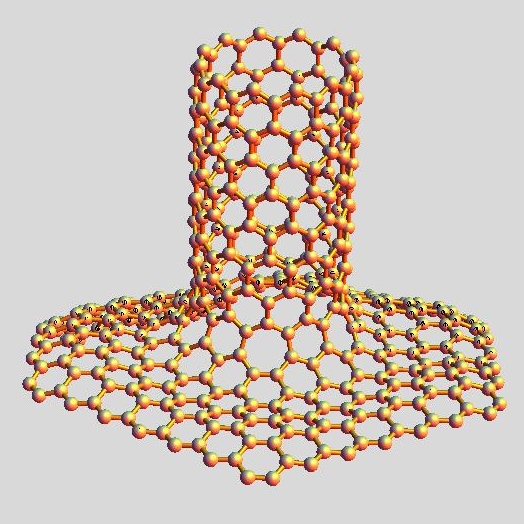
We have studied the electronic structure of the junctions between the graphene layer and carbon nanotubes, making use of the numerical diagonalization of tight-binding models as well as the continuum theory based on Dirac fermion fields. The latter provides in particular a unified description of different lattice structures with curvature, which is always localized at six heptagonal carbon rings around each junction. When these are evenly spaced, we have found that it is possible to curve the planar lattice into armchair (6n,6n) as well as zig-zag (6n,0) nanotubes. Paying attention to the local density of states, it has been possible to show that the junctions fall into two different classes, regarding the low-energy electronic behavior. One of them, constituted by the junctions made of the armchair nanotubes and the zig-zag (6n,0) geometries when n is a multiple of 3, is characterized by the presence of a peak very close to the Fermi level in the density of states, which is absent for the rest of the junctions with zig-zag nanotubes. We have seen that, in general, the local density of states tends to be depleted for angular momenta different from zero, with peaks above and below the Fermi level marking the threshold for the propagation of new states across the junction. The existence of a peak very close to the Fermi level turns out to be the reflection of quasi-bound states of the Dirac equation, which arise as a consequence of the effective magnetic flux induced by an appropriate configuration of the heptagonal rings. On the other hand, we have studied the electronic structure of the arrays of junctions, finding out that these can be also classified into two different groups according to the low-energy behavior. Thus, the arrays made of armchair and (6n,0) nanotubes with n equal to a multiple of 3 are characterized by the presence of a series of flat bands, whose number grows with the length of the nanotubes. We have shown that such flat bands have their origin in the existence of states confined to the nanotubes, with little overlap in the region between the junctions, and that correspond in the continuum theory to the formation of standing waves in the mentioned nanotube geometries. In general, we have concluded that the remarkable behavior predicted for these hybrid systems (localization and confinement of states, flat bands) opens good perspectives in the investigation of electronic devices with novel properties, whose development may be determined at last by the progress in the design of these structures (already fabricated by the Fujitsu company) in the laboratory.
Josephson junctions in graphene
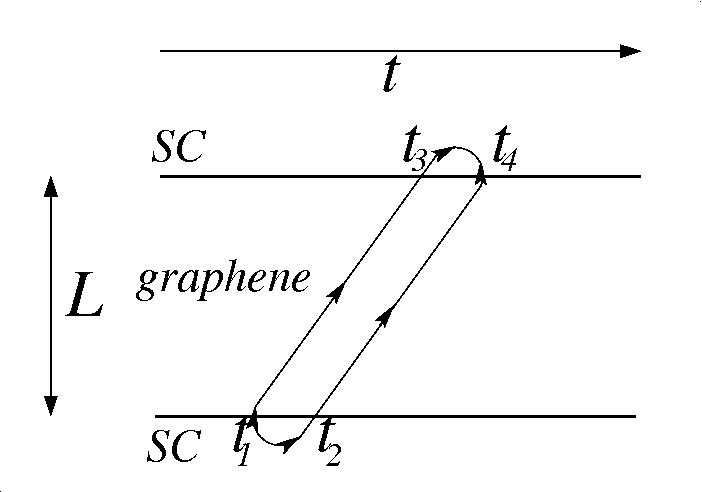
There have been experiments in which the transport properties of graphene are measured when it is contacted with superconducting electrodes. This has made possible the observation of supercurrents flowing through the carbon layer, for temperatures below the critical point of the electrodes. Our theoretical investigation has focused on the description of such supercurrents from the tunneling and subsequent propagation of the Cooper pairs in the graphene side of the junction. Thus we have shown that the supercurrents have a natural tendency to decay in the 2D system, following in general a power-law as a function of the distance L between the superconducting electrodes. The decay is particularly strong in undoped graphene, given the vanishing density of states at the neutrality point. We have established that, at zero temperature, the critical currents have a 1/L3 dependence on the distance L. At finite temperature, there is moreover a thermal length (inversely proportional to the thermal energy) beyond which the supercurrents are even more strongly suppressed, due to the disruption of the Cooper pairs by thermal effects. On the other hand, we have also taken into account the way in which many-body effects can increase the critical currents, by shifting the Fermi level away from the charge neutrality point. We have seen that the nonvanishing density of states thus generated leads to an enhancement of the critical currents above a new length scale inversely proportional to the Fermi level shift. The system enters then a new regime, where the above mentioned power-law decay is replaced by a 1/L2 dependence on the distance L between the electrodes. Our many-body framework has also provided evidence of the little significance that the interaction effects have on the Josephson currents, at the low temperatures required to measured them. This represents a great advantage with respect to one-dimensional junctions made with carbon nanotubes, where the repulsive electronic interaction induces a strong suppression of the density of states at the Fermi level. On the contrary, graphene shows a marked decrease of the electronic correlations at low energies, with a strong renormalization of the Coulomb interaction that makes it almost irrelevant at temperatures of the order of 1 K. From a practical point of view, our research has shown that it will be possible to establish supercurrents above the scale of 1 nA over distances of several hundred nanometers, at reasonably large doping levels. These results can be useful in the design of prototypes, for the purpose of amplifying the magnitude of the critical currents in electronic devices built from graphene.
Quantum Hall effect in carbon nanotubes and curved graphene
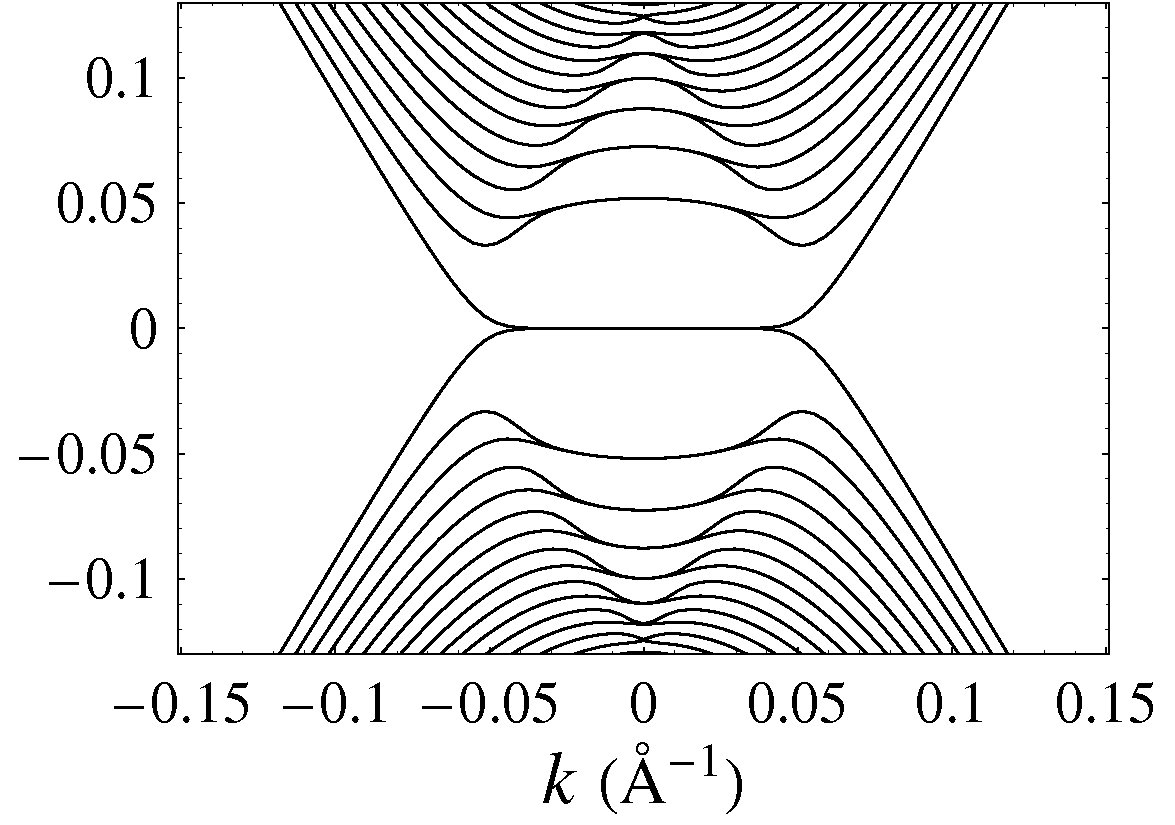
We have investigated the development of the Landau levels in two-dimensional carbon lattices, trying to understand the way in which the effects of a transverse magnetic field are modified by the curvature of the lattice and, in particular, by the change of the topology in the case of the carbon nanotubes. Starting from tight-binding models for the carbon π orbitals, we have proceeded to diagonalize in each case the lattice hamiltonian in order to find the degeneracy of the levels, as well as the edge states giving rise to the quantization of the conductance in the Hall effect. We have compared these results with those from the effective field theories obtained in the continuum limit, which account for the coupling between the vector potential and the Dirac fermions describing the electron quasiparticles. We have then attained a better understanding of the unconventional effects arising from the relativistic-like invariance of the low-energy electronic excitations in the carbon lattices. In the case of carbon nanotubes with large radius in sufficiently strong magnetic fields, we have shown in particular that the transport properties are governed by states localized at the flanks of the nanotube, which are responsible for the appearance of quantized currents in the longitudinal direction. We have pointed out the possibility of observing the quantization of the Hall conductivity in multi-walled nanotubes, where typically the outermost shell is only contacted by the electrodes in transport experiments. We have thus proposed an experimental design where the steps in the Hall conductivity would be reflected in the voltage drop across the transverse section of the nanotube, which could be suitably measured by means of scanning tunneling microscopy. |
